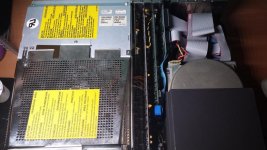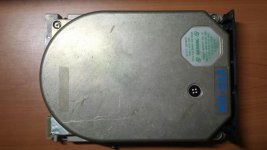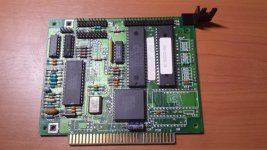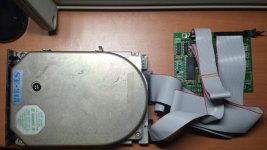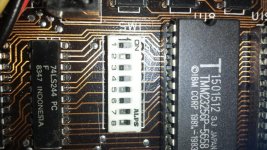PeterBrine
New Member
- Joined
- Apr 7, 2015
- Messages
- 4
Hello everyone, this is my first post in this forum. A few years ago, my dad and I pulled my dad's old IBM 5155 out of my grandfather's attic, plugged it in, and found that it was still working perfectly. I decided to take it out a few days ago and start messing around with it, but I couldn't access the hard drive. The floppy drive works fine and most of the games and programs I have for it still work.
Every time I boot up DOS and try to access the drive (using "cd C:") the computer just returns "Invalid drive specification". I've checked to make sure the hard drive is hooked up correctly to the controller (http://www.minuszerodegrees.net/5160/misc/5160_hard_drive_cabling_single.jpg), checked both the controller board and the hard drive board for any potential damage, and tried to make sure I have the right jumper settings. My questions are:
1. How can I begin to diagnose the problem? The only error code I've gotten is 1701, which is for a "fixed disk or adapter general error" (http://www.bioscentral.com/misc/ibmdiag.htm), and this was only when I started messing with the way the ribbon cables were connected to the drive.
2. If the problem is with the drive, is there any way I can fix it, or am I just going to have to get a new drive? Also, what drives, cards, operating systems, etc. are compatible with the 5155?
3. Am I trying to access the drive incorrectly? I've noticed that I can get to a B: drive, but it seems to just be the same thing as the A: drive. I also read something about drive IDs, can someone inform me as to what those are and if those would apply here?
If anyone needs pictures, just let me know. I don't know how to ID the controller card I have so if someone could tell me where to look that'd be awesome. I'm only 20 years old, so I have very little experience with this technology. Any information is greatly appreciated. Thanks in advance!
- Peter
Every time I boot up DOS and try to access the drive (using "cd C:") the computer just returns "Invalid drive specification". I've checked to make sure the hard drive is hooked up correctly to the controller (http://www.minuszerodegrees.net/5160/misc/5160_hard_drive_cabling_single.jpg), checked both the controller board and the hard drive board for any potential damage, and tried to make sure I have the right jumper settings. My questions are:
1. How can I begin to diagnose the problem? The only error code I've gotten is 1701, which is for a "fixed disk or adapter general error" (http://www.bioscentral.com/misc/ibmdiag.htm), and this was only when I started messing with the way the ribbon cables were connected to the drive.
2. If the problem is with the drive, is there any way I can fix it, or am I just going to have to get a new drive? Also, what drives, cards, operating systems, etc. are compatible with the 5155?
3. Am I trying to access the drive incorrectly? I've noticed that I can get to a B: drive, but it seems to just be the same thing as the A: drive. I also read something about drive IDs, can someone inform me as to what those are and if those would apply here?
If anyone needs pictures, just let me know. I don't know how to ID the controller card I have so if someone could tell me where to look that'd be awesome. I'm only 20 years old, so I have very little experience with this technology. Any information is greatly appreciated. Thanks in advance!
- Peter

